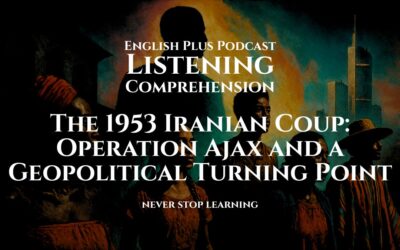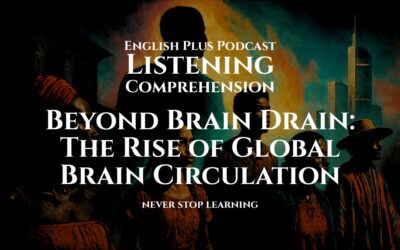Introduction to Listening & Listening Tips
Welcome to this advanced listening practice session! The ability to comprehend spoken English, especially in academic and nuanced contexts, is crucial for excelling in international exams like the SAT, TOEFL, and IELTS. Today, we’ll delve into the fascinating world of symbolism in classic novels, a topic that requires not just general comprehension but also the capacity to infer meaning and connect ideas.
To maximize your learning from this exercise, here are some listening tips and techniques frequently recommended for international exams:
- Pre-listening Strategy: Before the audio begins, quickly skim the questions if they are provided. This helps you anticipate the information you need to listen for. Even if not provided, take a moment to consider the topic – what kind of vocabulary might you hear? What are some common ideas associated with it?
- Active Listening: Don’t just hear the words; actively engage with the content. Try to identify the speaker’s main points, supporting details, and any shifts in topic or perspective. Pay attention to signal words and phrases that indicate cause and effect, contrast, or enumeration.
- Note-Taking: Develop a shorthand system for note-taking. You don’t need to write down every word. Focus on keywords, dates, names, and key concepts. Practice summarizing ideas concisely.
- Contextual Clues: If you encounter unfamiliar vocabulary, try to understand its meaning from the surrounding words and sentences. Speakers often provide definitions or examples implicitly.
- Inferential Listening: Many exam questions go beyond direct recall. You’ll need to infer the speaker’s attitude, purpose, or implied meaning. This requires connecting different pieces of information presented in the audio.
- Practice, Practice, Practice: The more you listen to a variety of accents and topics, the more comfortable and proficient you’ll become. Don’t be discouraged by initial difficulties; consistent effort leads to significant improvement.
Now, let’s sharpen our listening skills with a discussion on the rich symbolism embedded within classic literature.
Focus on Listening
Listening Comprehension Quiz
Listening Transcript
Listening Transcript: Please don’t read the transcript before you listen and take the quiz.
Good morning, everyone, and welcome to today’s literary seminar. Our focus today is on a profoundly enriching aspect of classic literature: the intricate world of symbolism. Often, when we read a novel, we’re drawn into the narrative, the characters, and the plot. But beneath the surface, especially in those works deemed “classic,” lies a deeper layer of meaning, a tapestry woven with symbolic threads that elevate the text from a mere story to a profound commentary on human existence, societal norms, or philosophical concepts.
Symbolism, at its core, is the use of objects, people, or ideas to represent something else. It’s not always immediately apparent, and that’s precisely what makes its exploration so rewarding. A seemingly ordinary object, a particular color, a recurring motif, or even a specific setting can carry a weight of significance far beyond its literal presence. Understanding these symbolic layers is crucial not just for academic analysis, but for a truly immersive and appreciative reading experience.
Let’s consider some prominent examples. Take Herman Melville’s Moby Dick. On the surface, it’s an epic tale of Captain Ahab’s obsessive hunt for a white whale. However, Moby Dick himself is far more than just a large marine mammal. He is widely interpreted as a multifaceted symbol. For some, he represents the untamable forces of nature, a primordial power that humanity, despite its technological advancements, can never truly conquer. For others, Moby Dick embodies the destructive nature of obsession, the all-consuming pursuit that ultimately leads to ruin. The whiteness of the whale itself is often debated: is it purity, a blank slate, or perhaps the terrifying emptiness of the unknown? The ambiguity is part of its power, allowing for a richness of interpretation that continues to fascinate scholars.
Another compelling instance can be found in F. Scott Fitzgerald’s The Great Gatsby. The green light at the end of Daisy’s dock is perhaps one of the most famous literary symbols. Literally, it’s just a light across the bay. Symbolically, however, it encapsulates Gatsby’s yearning, his unattainable dream of recapturing the past and winning Daisy’s love. It represents the American Dream itself – the hope, the desire, the illusion, and ultimately, the tragic unattainability of a dream rooted in an idealized past. The Valley of Ashes, a desolate wasteland situated between West Egg and New York City, serves as a stark symbol of the moral and social decay that lies beneath the glittering facade of the Jazz Age, representing the plight of the working class exploited by the wealthy elite. Even the weather often mirrors the emotional intensity of the characters and the plot, a subtle but effective form of pathetic fallacy.
Moving to a more allegorical text, George Orwell’s Animal Farm is a powerful example of sustained symbolism. The entire narrative functions as an allegory for the Russian Revolution and the subsequent rise of Stalinism. Each animal character and event within the farm directly corresponds to real historical figures and events. Old Major, the wise pig, symbolizes Marx or Lenin; Napoleon, the tyrannical pig, represents Stalin; and Boxer, the hardworking horse, symbolizes the exploited proletariat. The windmill, initially a symbol of progress and prosperity for the animals, ultimately becomes a symbol of their exploitation and the broken promises of the revolution. The transformation of the pigs, who initially advocated for equality, into oppressive rulers indistinguishable from humans, is a chilling symbolic representation of the corrupting nature of absolute power.
It’s important to remember that symbolism isn’t always overt. Sometimes it’s subtly woven into the fabric of the narrative, requiring close reading and thoughtful reflection. For instance, in Emily Brontë’s Wuthering Heights, the wild, untamed moors surrounding the Earnshaw and Linton estates are more than just a backdrop; they actively symbolize the raw, passionate, and often destructive nature of Catherine and Heathcliff’s love. The weather on the moors, frequently tempestuous and unpredictable, mirrors the turbulent emotions and conflicts within the characters. The contrasting architectural styles of Wuthering Heights and Thrushcross Grange—one rugged and isolated, the other refined and orderly—symbolize the fundamental differences in their respective inhabitants’ temperaments and social standing.
Another key aspect of symbolism is that it often invites multiple interpretations. There isn’t always one definitive “correct” answer, which makes literary analysis so dynamic. What one reader perceives as a symbol of hope, another might see as a symbol of illusion. This multiplicity of meaning enriches the reading experience and allows for ongoing critical discourse. The key is to be able to articulate your interpretation and support it with evidence from the text.
So, how can you, as a reader, become more adept at identifying and interpreting symbolism? Firstly, pay attention to recurring images, objects, or phrases. If something appears multiple times, it likely carries a deeper significance. Secondly, consider the context. What is happening in the story when a particular symbol appears? How do characters react to it? Thirdly, think about universal archetypes and cultural associations. For example, a dove often symbolizes peace, and a serpent often represents temptation or evil, due to their long-standing cultural and religious associations. However, be careful not to over-interpret; not everything is a symbol. Sometimes a cigar is just a cigar, as Freud supposedly remarked. The challenge lies in distinguishing incidental details from purposeful symbolic constructs.
Ultimately, delving into the symbolic landscape of classic novels is a profoundly rewarding intellectual exercise. It deepens our understanding of literature, enhances our critical thinking skills, and allows us to connect with profound human truths that transcend time and culture. As you continue your literary journey, I encourage you to look beyond the literal, to peel back the layers, and discover the hidden meanings that make these classic works so enduringly powerful. Thank you.
Keywords and Phrases
- Intricate world of symbolism: This refers to the complex and detailed nature of how symbols are used in literature. When we say something is “intricate,” we mean it has many interconnected parts, like a finely woven tapestry. In our listening, it highlights that symbolism isn’t simple but rather a rich and nuanced system of meaning.
- Tapestry woven with symbolic threads: Imagine a beautiful, detailed cloth made from many different threads. This phrase is a metaphor to describe how different symbols (the “threads”) are combined to create a larger, deeper meaning (the “tapestry”) within a story. It emphasizes the interconnectedness and artistic construction of symbolic meaning.
- Elevate the text from a mere story to a profound commentary: To “elevate” something means to raise its status or quality. When symbolism “elevates” a story, it means it takes the narrative beyond just telling events and gives it a much deeper, more significant message or critique about life, society, or philosophy. A “profound commentary” is a very deep and insightful analysis.
- Multifaceted symbol: If something is “multifaceted,” it has many different aspects, sides, or interpretations. So, when Moby Dick is described as a “multifaceted symbol,” it means that different people can find various significant meanings in the whale, rather than just one straightforward interpretation.
- Primordial power: “Primordial” refers to something existing at the very beginning, something fundamental and ancient. When we talk about Moby Dick representing “primordial power,” it means a force of nature that is fundamental, existed before humanity, and is beyond our control or understanding.
- Stark symbol: “Stark” means sharp, severe, or absolute. A “stark symbol” is one that clearly and powerfully represents something, often something unpleasant or harsh. The Valley of Ashes was a “stark symbol” because it very clearly and bleakly represented social decay.
- Glittering facade: A “facade” is the front of a building, or a superficial appearance that hides what’s behind it. “Glittering” suggests something shiny and attractive but often deceptive. So, the “glittering facade” of the Jazz Age refers to the outward appearance of wealth and glamour that hid underlying problems and moral decay.
- Sustained symbolism: This phrase describes symbolism that is consistent and runs throughout an entire work, rather than just appearing in isolated instances. In Animal Farm, the “sustained symbolism” means that the entire story, its characters, and events consistently represent the Russian Revolution.
- Allegorical text: An “allegory” is a story, poem, or picture that can be interpreted to reveal a hidden meaning, typically a moral or political1 one. An “allegorical text” is a work where the characters and events are symbolic of a deeper, often political or moral, truth. Animal Farm is a prime example because it’s a story about animals that clearly represents human history.
- Corrupting nature of absolute power: This refers to the idea that having complete, unchecked power tends to make people (or pigs, in Animal Farm!) morally bad or dishonest. The script uses this to explain how the pigs’ transformation showed that “absolute power” inevitably “corrupts” those who wield it.
- Subtly woven into the fabric of the narrative: If something is “subtly woven,” it means it’s included in a delicate, understated, and not obvious way. The “fabric of the narrative” refers to the entire structure and content of the story. So, symbolism that’s “subtly woven” means it’s seamlessly integrated into the story, requiring careful attention to notice.
- Critical discourse: “Discourse” refers to written or spoken communication or debate. “Critical discourse” specifically means the ongoing discussion, analysis, and debate among scholars and readers about a particular topic, like literary interpretations. The speaker mentions that the “multiplicity of meaning” in symbols allows for “ongoing critical discourse.”
- Universal archetypes and cultural associations: An “archetype” is an original model or a typical example of something, often a recurring symbol or motif in literature or mythology (e.g., the hero, the villain). “Cultural associations” are the meanings or ideas commonly linked to something within a particular culture. The speaker suggests considering these when interpreting symbols because they often carry widely understood meanings.
- Incidental details from purposeful symbolic constructs: “Incidental details” are minor, unimportant elements that just happen to be there. “Purposeful symbolic constructs” are elements that have been intentionally placed in the text by the author to carry a deeper symbolic meaning. The challenge for a reader is to tell the difference between something that’s just a detail and something that’s meant to be a symbol.
- Enduringly powerful: If something is “enduringly powerful,” it means it remains strong, significant, and impactful over a very long time. Classic novels are described this way because their themes and symbolic meanings continue to resonate and affect readers across generations.










0 Comments